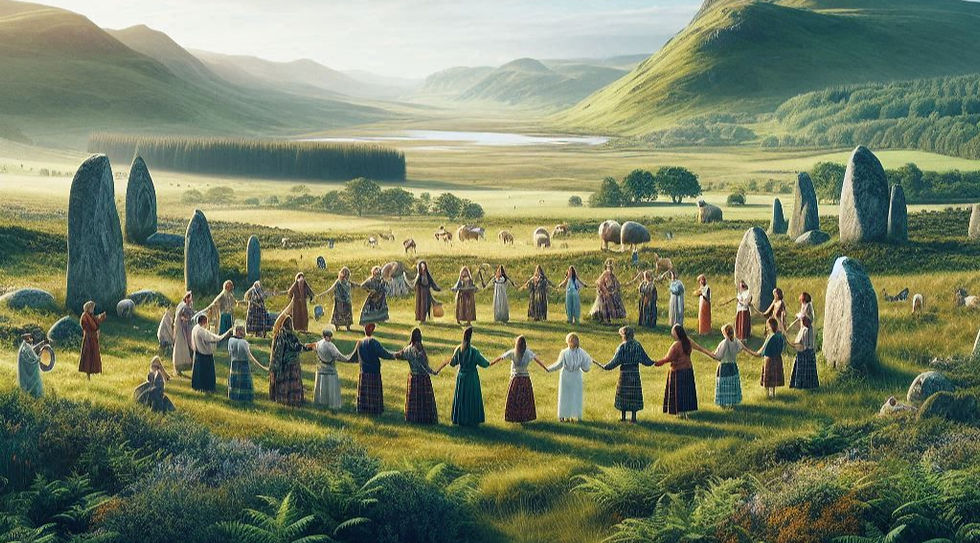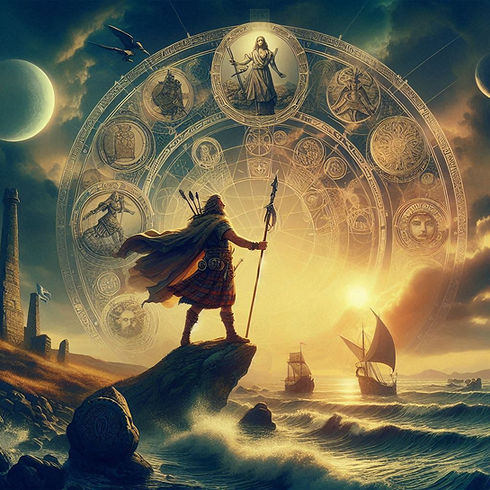

Scottish Paganism
Ancient Tradition
Place of Origin: Scotland
Founded: Prehistoric Era (exact date unknown)
Major Figures: Deities and spirits specific to Scotland, such as Beira, Brighid, the Cailleach and kelpies.
Major Festivals: Samhain, Beltane, Imbolc, and Lughnasadh.
Rituals: Scottish paganism emphasized rituals and ceremonies to honor nature, ancestors, and the spiritual world. These rituals included seasonal festivals (such as Samhain and Beltane), ancestor worship, animal totem ceremonies, and nature worship. Sacred sites like the Callanish Stones were central to these practices, which aimed to maintain harmony with the natural world.
Origins and Development
Scottish Paganism, or Celtic Paganism, has its roots in the ancient spiritual practices of the Celtic peoples who inhabited Scotland and other parts of Europe. These practices date back to the Iron Age and possibly earlier. The Celts were a group of tribes with shared cultural and linguistic characteristics, and their spiritual beliefs were centered around the reverence for nature, the cycles of the seasons, and the worship of a pantheon of deities. Over time, these beliefs evolved and were influenced by interactions with other cultures, including the Romans and early Christians.
Ancient Tradition
Scottish Paganism is an ancient tradition that evolved over centuries. The ancient Celts practiced a polytheistic religion with a pantheon of gods and goddesses, and their spiritual practices were passed down through generations by druids, who were the priestly class responsible for religious rituals, education, and maintaining oral traditions. The absence of written records from the pre-Christian Celtic period means that much of our knowledge comes from later sources, such as Roman accounts and medieval manuscripts.
Sacred Texts
There are no specific sacred texts associated with ancient Scottish Paganism, as much of the knowledge was transmitted orally. However, modern practitioners often refer to ancient Celtic myths, folklore, and literature to understand and revive these traditions.
Scottish Mythology
Scottish mythology is a rich tapestry woven from the diverse cultural influences of the Gaelic, Pictish, and Norse peoples who inhabited the region over the centuries. This blend of traditions has given rise to a unique and fascinating collection of myths, legends, and deities.
Gaelic Influences
The Gaelic influence in Scottish mythology is particularly strong, as the Gaels were one of the earliest groups to settle in Scotland. They brought with them a rich oral tradition of stories and legends that often centered around nature, the supernatural, and heroic deeds. Key figures from Gaelic mythology include:
-
Brìghde (Bride): A goddess of healing, poetry, and fertility, often celebrated during the festival of Imbolc. She is known for her association with fire and the coming of spring.
-
Fionn mac Cumhaill (Finn MacCool): A legendary hero and leader of the Fianna, a group of warriors. His stories include adventures, battles, and magical encounters.
Pictish Influences
The Picts were an ancient people who lived in what is now Scotland before the arrival of the Gaels. Their culture and beliefs have left a significant mark on Scottish mythology, particularly in the form of mysterious symbols and stone carvings. Notable Pictish elements in Scottish mythology include:
-
The Cailleach: Often referred to as the "Hag of Winter," the Cailleach is a primordial goddess associated with winter, storms, and the creation of the landscape. She is believed to shape the land with her elemental powers and is a key figure in Pictish and later Scottish folklore.
Norse Influences
The Viking invasions and subsequent settlements in Scotland brought Norse myths and deities into the mix, further enriching the Scottish mythological landscape. Notable Norse influences include:
-
Norse Gods: Some Norse deities, such as Odin and Thor, found their way into Scottish stories, often blending with local legends.
-
Norse Legends: Tales of Norse heroes and mythical creatures, such as giants and dragons, also became part of Scottish mythology.
Notable Figures
-
Selkies: These mythical seal-people are a prominent feature in Scottish folklore. Selkies are believed to live as seals in the sea but can shed their skins to become human on land. Stories about selkies often explore themes of love, loss, and longing, as they navigate the delicate balance between their two worlds.
-
Nessie (Loch Ness Monster): While not a deity, Nessie is one of the most famous mythological creatures in Scotland. The legend of the Loch Ness Monster, a mysterious creature said to inhabit Loch Ness, has captured the imagination of people around the world and symbolizes the mysteries that lie within Scotland's deep, dark lochs.
Cultural Significance
Scottish mythology is not just a collection of old tales; it continues to influence modern Scottish culture, from literature and art to festivals and tourism. Many of these myths and legends are still celebrated and retold, keeping the ancient traditions alive and connecting contemporary Scots with their rich heritage.
Deities/Key Figures
The Celtic pantheon includes a variety of deities, each associated with different aspects of life and nature. Some of the key deities include:
-
Lugh: God of skill, craftsmanship, and the sun.
-
Toutatis: Protector of tribes and embodiment of collective strength.
-
Cernunnos: God of animals, forests, and fertility.
-
Brighid: Goddess of healing, poetry, and smithcraft.
-
Beira: Goddess of winter and storms.
-
Selkies: Mythical seal folk who can transform into humans and are often featured in tales of love and loss.
Growth
The revival of Scottish Paganism, along with other forms of modern Paganism, began in the late 19th and early 20th centuries as part of a broader interest in ancient and indigenous spiritual traditions. The movement gained momentum in the 1960s and 1970s with the rise of neo-paganism and Wicca. Today, Scottish Paganism continues to grow as people seek to reconnect with nature and ancient cultural heritage.
Core Beliefs
The core beliefs of Scottish Paganism revolve around the reverence for nature and the belief in multiple deities. It emphasizes the interconnectedness of all living things and the importance of living in harmony with the natural world.
-
Polytheism: The belief in multiple deities, each associated with different aspects of life and nature.
-
Nature Reverence: A deep respect for the natural world and the cycles of the seasons.
-
Ancestral Veneration: Honoring and remembering ancestors, incorporating their wisdom and traditions.
-
Interconnectedness: The belief that all living things are interconnected and that humans are a part of the natural world.
Rituals and Practices
Rituals and practices in Scottish Paganism include:
-
Seasonal Celebrations: Marking the solstices, equinoxes, and cross-quarter days with festivals such as Samhain, Beltane, Imbolc, and Lughnasadh.
-
Nature Worship: Conducting rituals in natural settings like forests, rivers, and mountains.
-
Offerings: Making offerings to deities and spirits, often involving food, drink, and symbolic items.
-
Druidic Practices: Engaging in practices such as divination, storytelling, and the use of sacred plants.
Symbol
The primary symbol associated with Scottish Paganism is the Triskelion, a three-legged symbol representing progress, movement, and the three realms of material existence: earth, sea, and sky.
Cultural Impact
Scottish Paganism has had a significant cultural impact, influencing art, literature, and modern spiritual practices. It has also contributed to the preservation of Celtic heritage and traditions, inspiring contemporary movements that seek to reconnect with ancient beliefs and practices.
Global Presence
While Scottish Paganism originated in Scotland, it has gained a global presence through the revival of Celtic traditions and the spread of modern Paganism. Practitioners can be found in various parts of the world, particularly in Western countries.
Enduring Legacy
The enduring legacy of Scottish Paganism lies in its ability to adapt and evolve while maintaining its core principles. It continues to inspire modern spiritual seekers and contributes to the rich tapestry of global religious diversity. Its emphasis on nature, interconnectedness, and respect for the past resonates with contemporary concerns about the environment and cultural heritage.




